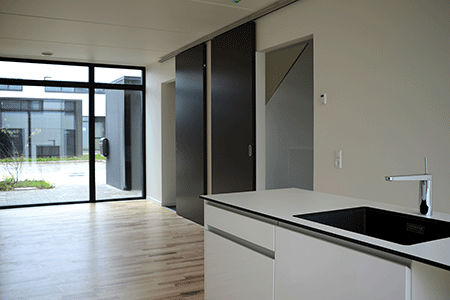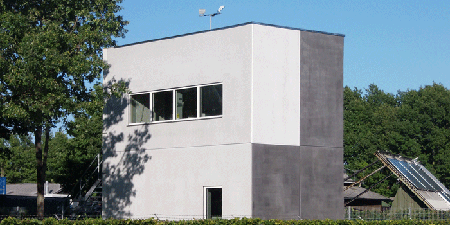Minimum thickness, low weight and remarkable insulation. A new construction system featuring high-strength concrete is good news for the climate. It can be used both in new builds and in renovation projects to improve the energy properties of existing buildings.
As the name suggests, ‘high-strength concrete’ is a very strong material. In practice, this allows the construction of buildings with exterior walls just 36 cm thick, which is half the conventional thickness of 72 cm. These thinner walls free up a lot of space. For example, in a building with 100 m2 of floor space, using high-strength concrete will add an extra 10 m2—corresponding to an extra children’s room—the usable area.
Combination of excellent properties
The new construction system combines the best properties from light construction materials (steel and wood) with the benefits offered by heavy materials (concrete and brick). The system is what is known as a ‘sandwich system’, where the elements involved are built up in layers—just like in a sandwich. The front and rear sections in a high-strength concrete unit are made of slim sheets of high-strength concrete, and they encapsulate a core material of highly efficient insulation. This design ensures maximum insulation capacity with minimum wall thickness.
The system has been developed for constructing new low-energy buildings and as for use in the renovation of existing buildings to improve their energy properties. “High-strength concrete has great potential in renovation projects as it is easy to handle, does not require scaffolding, and can be installed whatever the weather conditions,” explains Karsten Bro, Project Manager at the company Connovate.


Student housing on Aarhus harbourfront
Climate-friendly solution
The high-strength concrete construction system is a climate-friendly solution. Using high-strength concrete makes it possible to cut CO
2-emissions appreciably, as Professor Henrik Stang, Vice-Director at DTU Civil Engineering, explains:
“Concrete is largely composed of cement, and the production of cement is incredibly energy-intensive. In fact, cement production accounts for five per cent of global CO
2-emissions. So the less cement we produce, the better it is for the climate. And if we can construct buildings whose walls are only half as thick as usual, we can eliminate appreciable volumes of CO
2.”
In addition to the fact that the production of high-strength concrete does not adversely impact the carbon accounts, the light weight of the units means that less energy is required to transport them to a construction site—and to manoeuvre them into place when they arrive. This translates into an additional reduction in CO2-emissions. It is estimated that construction using high-strength concrete will help cut carbon emissions by up to 60 per cent in relation to construction using conventional concrete elements.
Cheap housing for poor countries
While the population of Denmark devotes a lot of energy to heating their homes, people in other parts of the world use just as much energy to cool theirs. The high-strength concrete construction system thus has appreciable potential in the hotter countries of the world, as its excellent insulation properties can help to keep buildings cool on the inside.
The team behind the high-strength concrete have even developed a transportable factory that allows the sandwich units to be manufactured locally—even though the construction site may be located on a different continent. The solution is currently being tested in South Africa, where 92 cooperative farms near Johannesburg are scheduled for completion in early 2014.
“Our low-cost building system can be used to ensure cheap housing for poor people all over the world, with local materials and labour being used in the construction process itself,” explains Karsten Bro.
The new high-strength concrete has a great many uses, in the contexts of both new builds and energy renovation projects for existing buildings. Photos: Kontraframe

Terrassed houses in the suburbs of Aarhus |

Low-cost houses in Johannesburg, Africa
|
Test building at DTU
DTU Civil Engineering has contributed to the development of high-strength concrete by researching areas such as the material properties of the concrete, its impact on the indoor climate, how it behaves in the presence of fire, its stiffness, its strength ratio and the risk of crack formation.
 Test house at DTU
Test house at DTU
In partnership with Connovate, DTU has even had a test building constructed at its Lyngby campus. This building will constitute a cornerstone of the future development of high-strength concrete. Professor Henrik Stang explains: “The test building allows us to monitor how the concrete behaves over a protracted period. We can take measurements of the house itself and trace how the materials age and how this affects the insulation capacity of the concrete. It is essential that we do this, as it will allow us to develop both the material itself and the construction elements.”
The new high-strength concrete sandwich elements were officially launched in October 2013.
- High-strength concrete requires only 40 per cent of the cement used in conventional concrete elements.
- A high-strength concrete element are only a third of the weight of corresponding standard sandwich elements.
- Highly fire-retardant: can withstand 1,050 °C for 90 minutes.
- Not affected by weather: renovation elements can be installed in all weather conditions.
- A high-strength concrete sandwich element costs the same as a high-quality conventional concrete element with corresponding insulation properties.
- Has the potential to serve as a low-cost building system all over the world, with the elements being made ‘on location’ using a mobile factory.
- Can be used for both new builds and renovation projects.